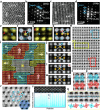Polymorphic relaxor phase and defect dipole polarization co-reinforced capacitor energy storage in temperature-monitorable high-entropy ferroelectrics
- PMID: 39984507
- PMCID: PMC11845462
- DOI: 10.1038/s41467-025-57139-4
Polymorphic relaxor phase and defect dipole polarization co-reinforced capacitor energy storage in temperature-monitorable high-entropy ferroelectrics
Abstract
Energy storage high-entropy ceramics are famous for their ultrahigh power density and ultrafast discharge rate. However, achieving a synchronous combination of high energy density and efficiency along with intelligent temperature-monitorable function remains a significant challenge. Here, based on high-entropy strategy and phase field simulation, the polarization response of domains in Bi0.5Na0.5TiO3-based ceramics is optimized by constructing a concomitant nanostructure of defect dipole polarization and a polymorphic relaxor phase. The optimal ceramic possesses a high recyclable energy storage density (11.23 J cm-3) and a high energy storage efficiency (90.87%) at 670 kV cm-1. Furthermore, real-time temperature sensing is explored based on abnormal fluorescent negative thermal expansion, highlighting the application of intelligent cardiac defibrillation pulse capacitors. This study develops an effective strategy for enhancing the overall energy storage performance of ferroelectric ceramics to overcome the problems of insufficient energy supply and thermal runaway in traditional counterparts.
© 2025. The Author(s).
Conflict of interest statement
Competing interests: The authors declare no competing interests.
Figures





References
-
- Yang, B. et al. High-entropy enhanced capacitive energy storage. Nat. Mater.21, 1074–1080 (2022). - PubMed
-
- Ploehn, H. J. Composite for energy storage takes the heat. Nature523, 536–537 (2015). - PubMed
-
- Yang, B. et al. Engineering relaxors by entropy for high energy storage performance. Nat. Energy8, 956–964 (2023).
-
- Zhang, M. et al. Ultrahigh energy storage in high-entropy ceramic capacitors with polymorphic relaxor phase. Science384, 185–189 (2024). - PubMed
-
- Oses, C., Toher, C. & Curtarolo, S. High-entropy ceramics. Nat. Rev. Mater.5, 295–309 (2020).
LinkOut - more resources
Full Text Sources

